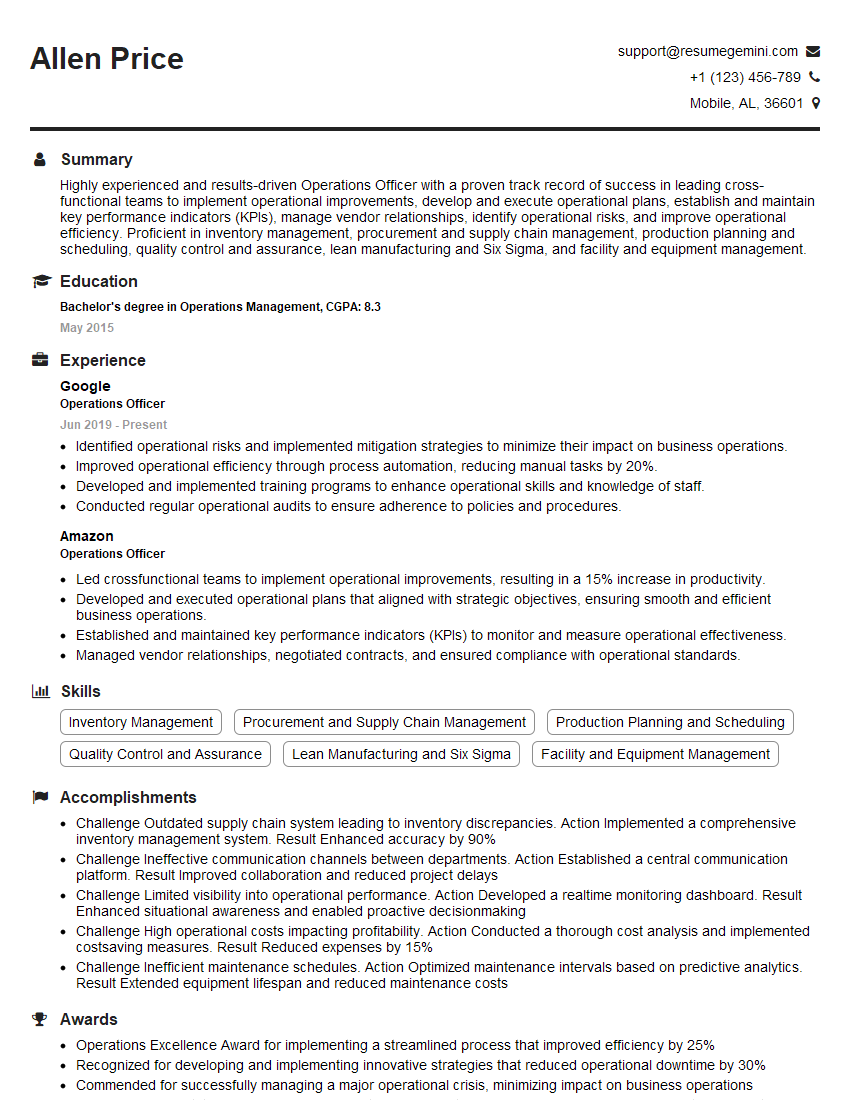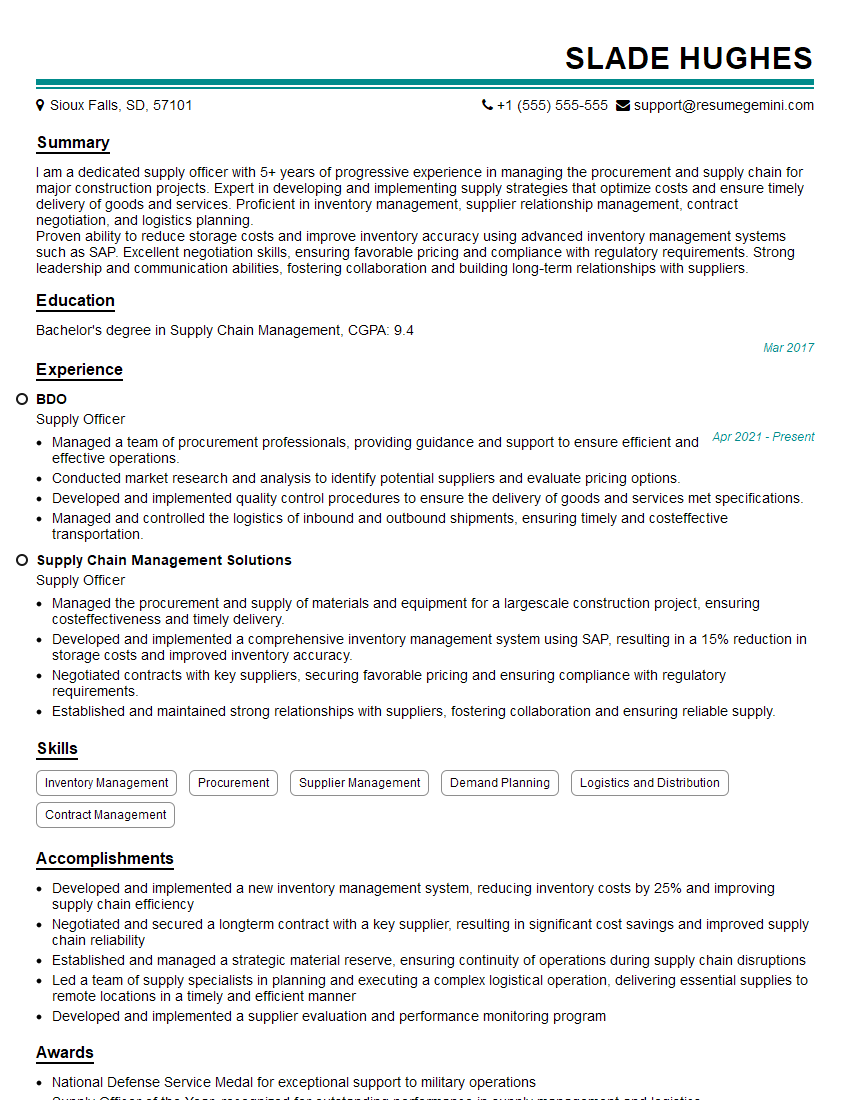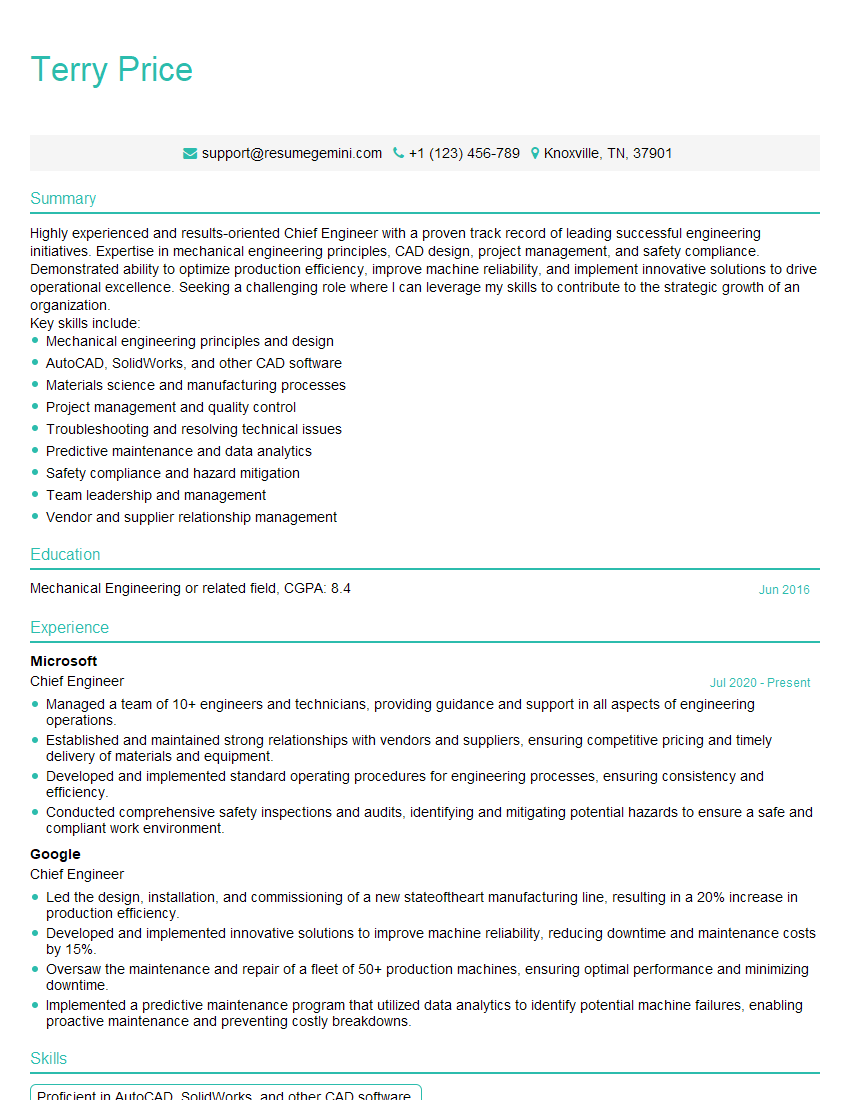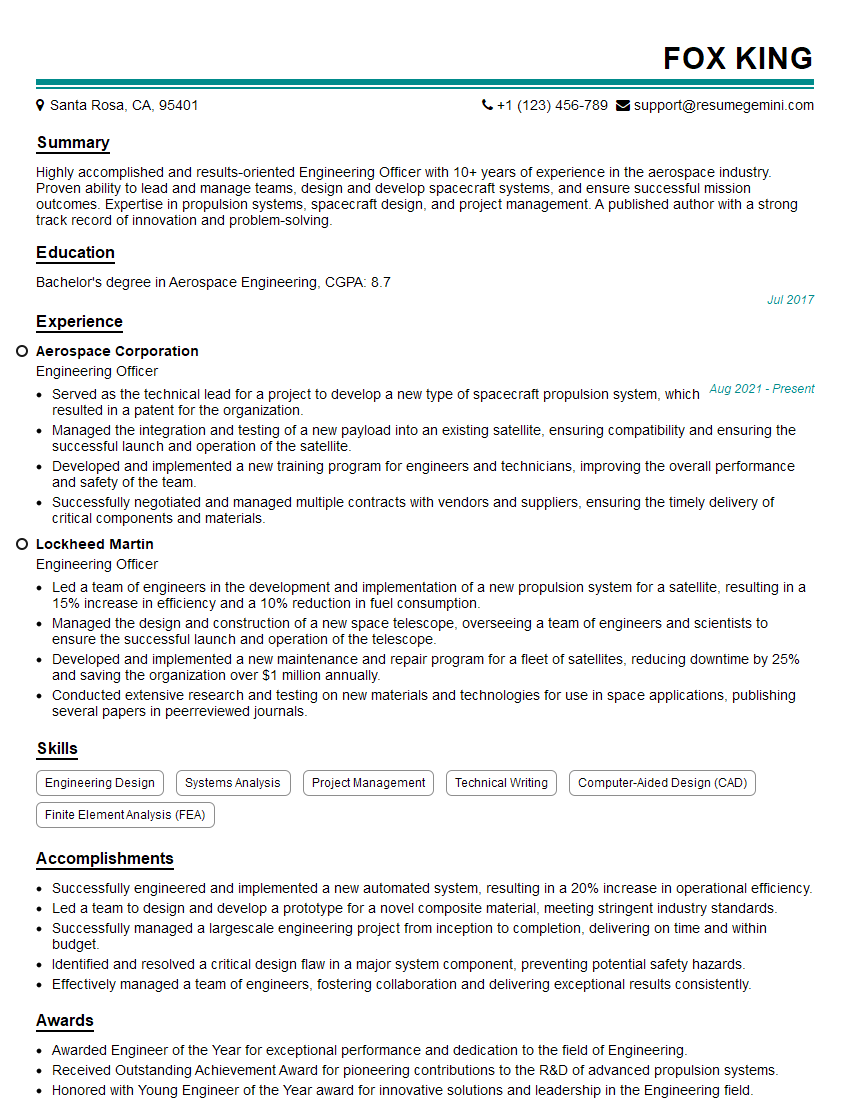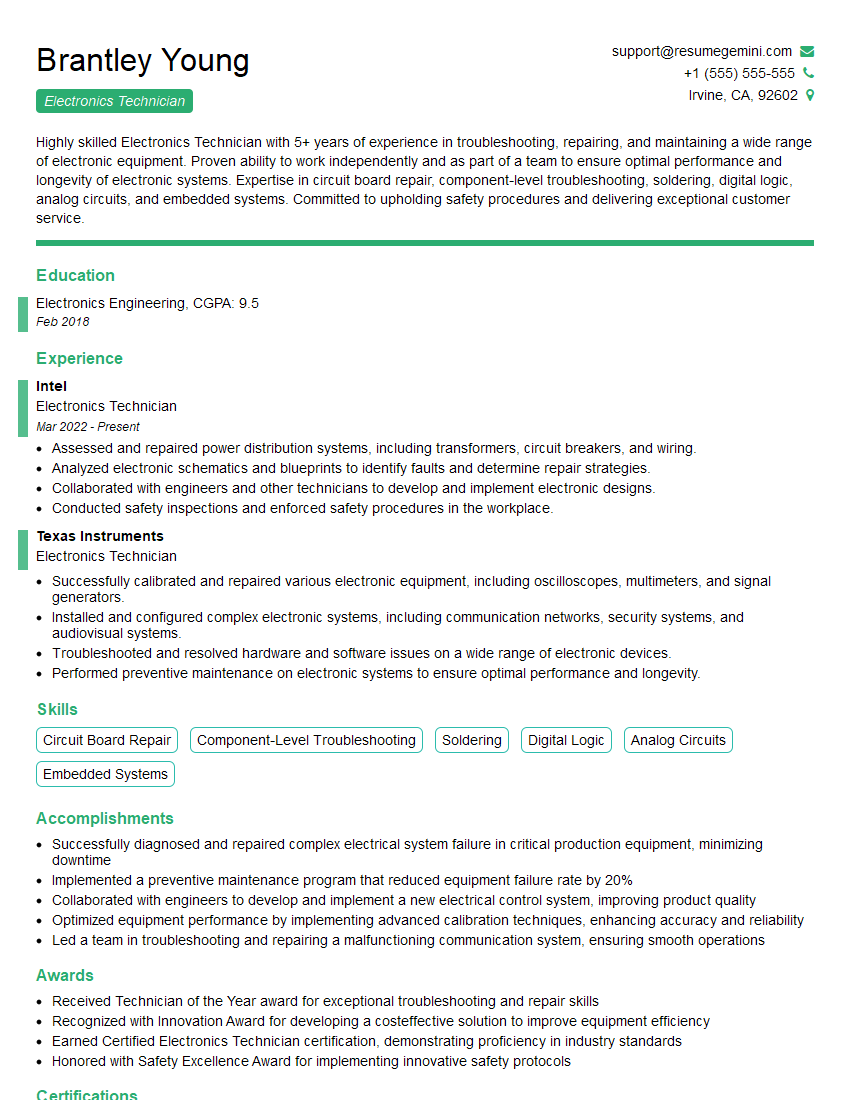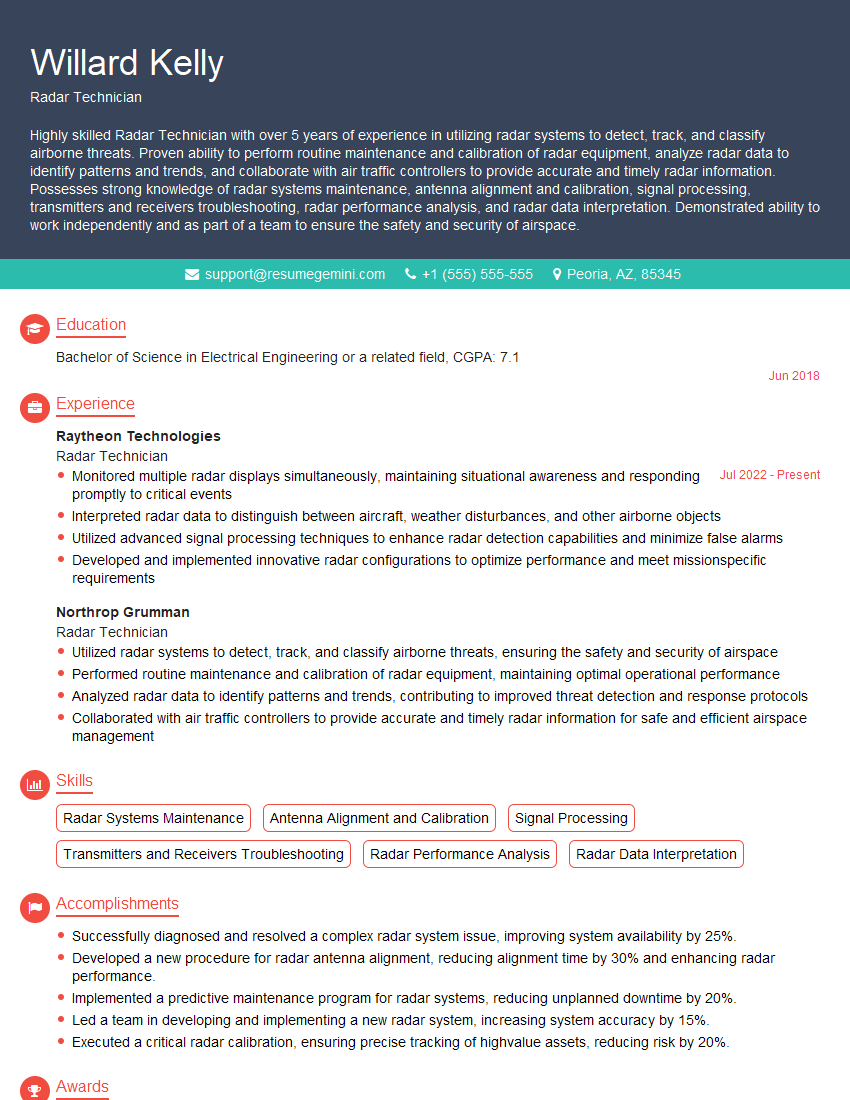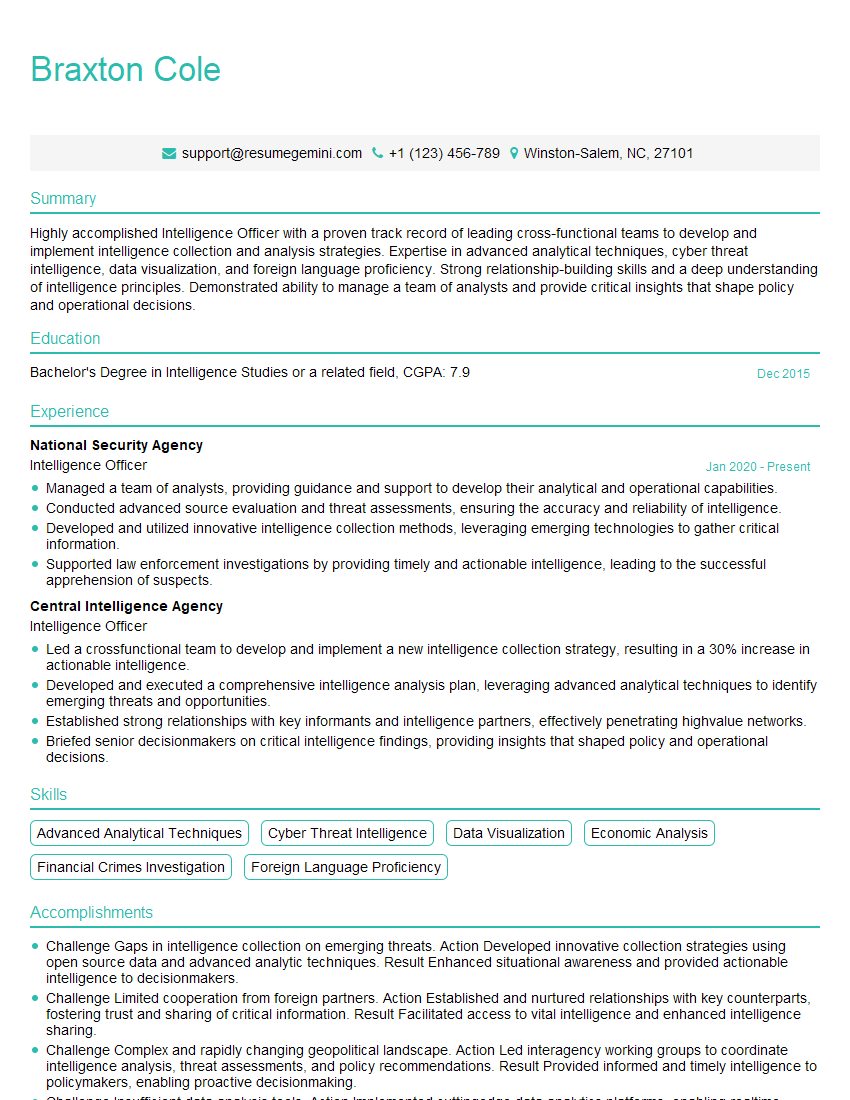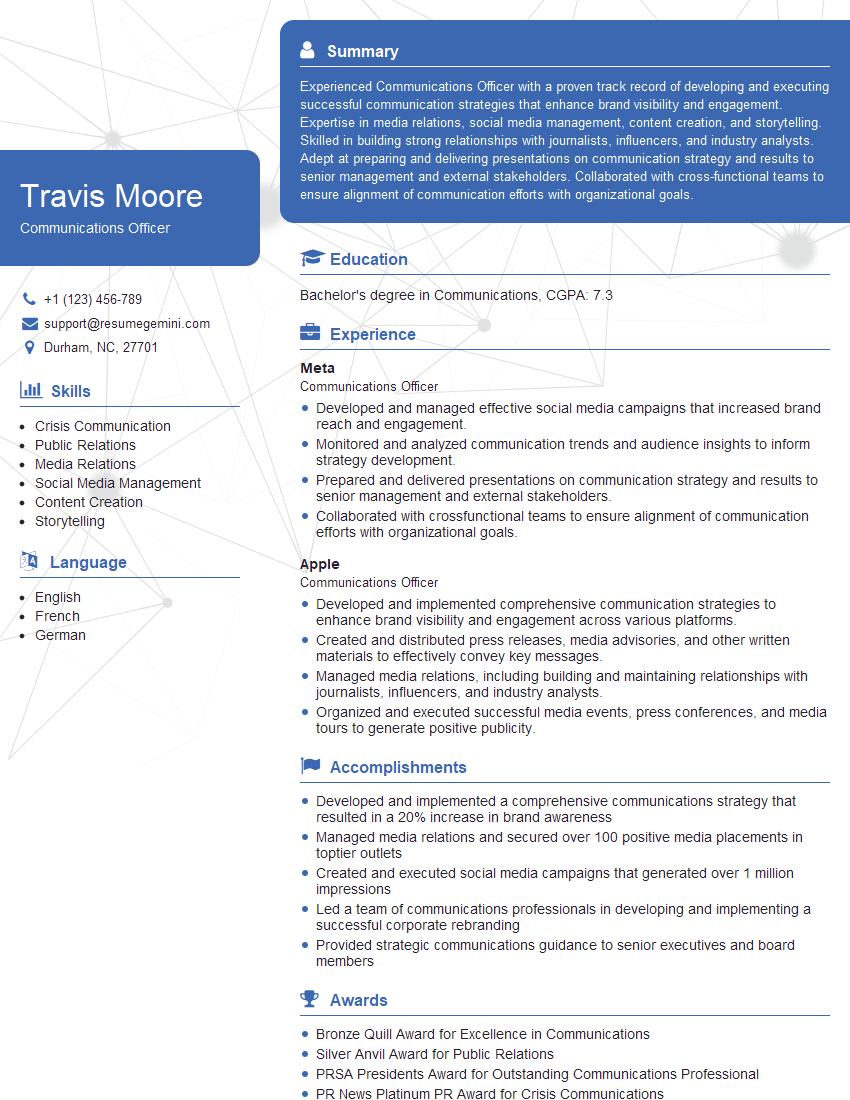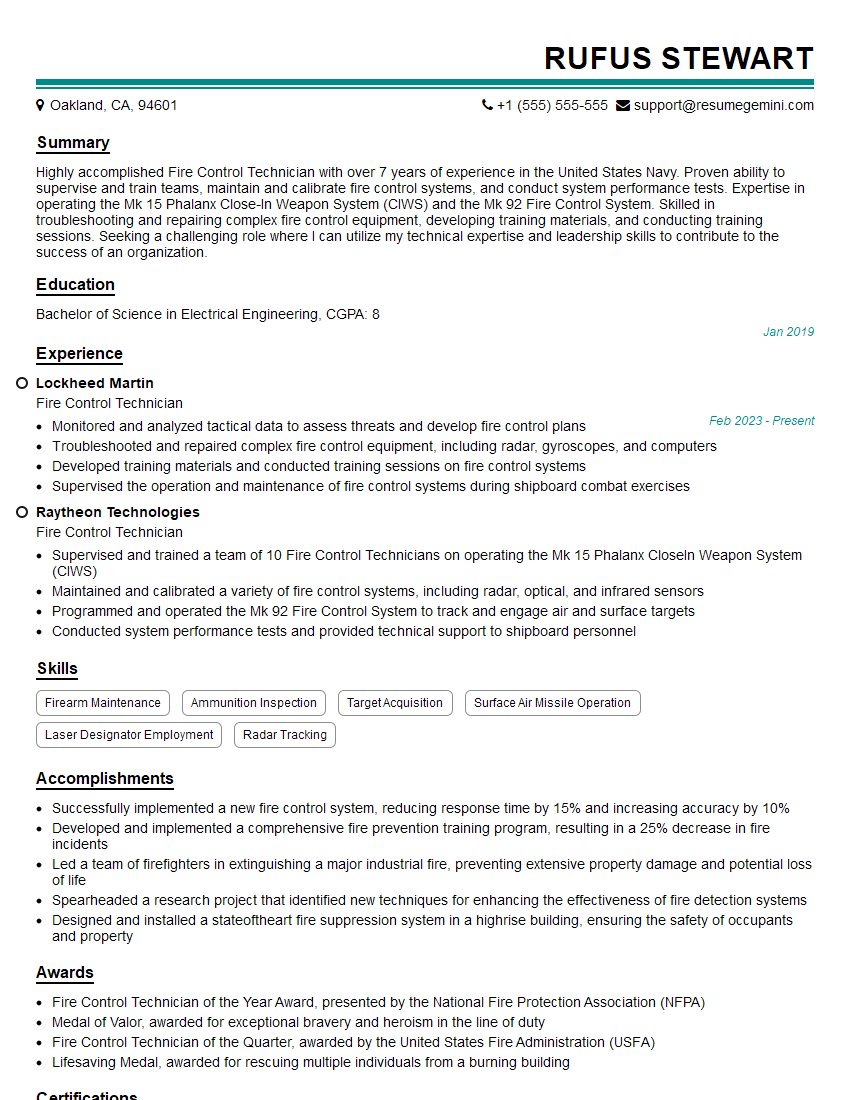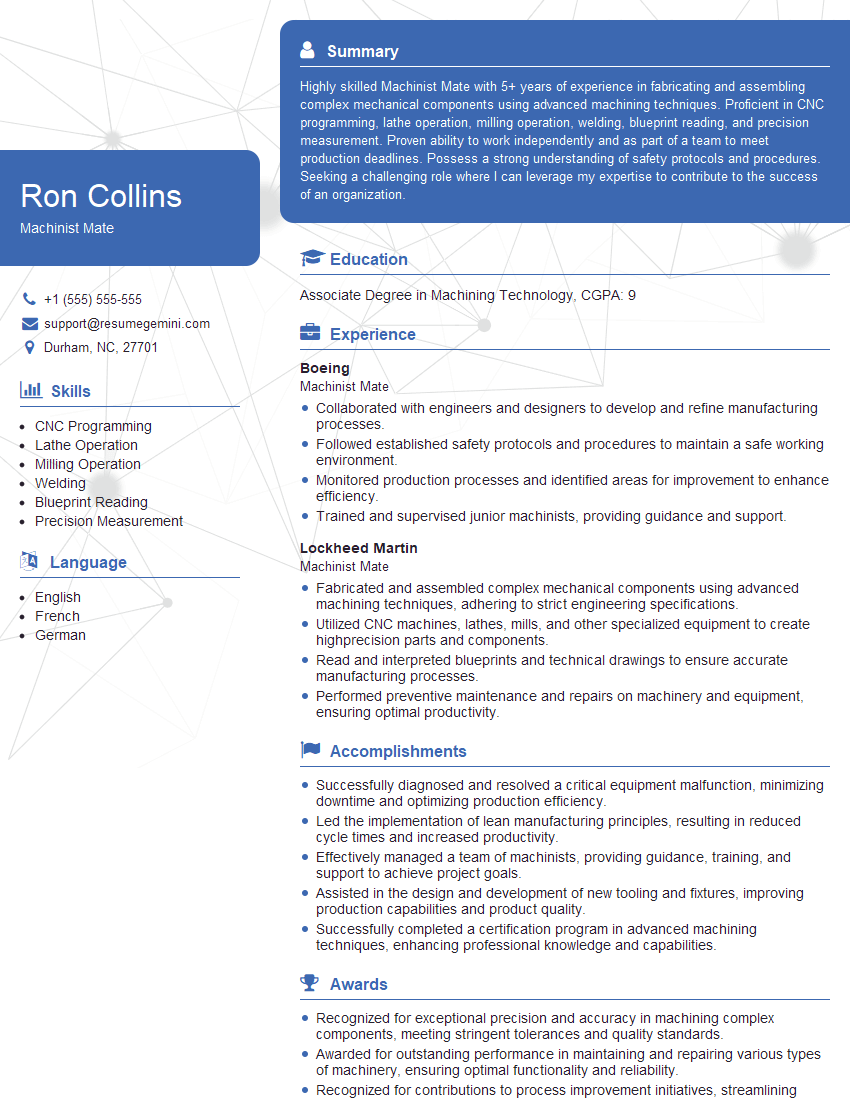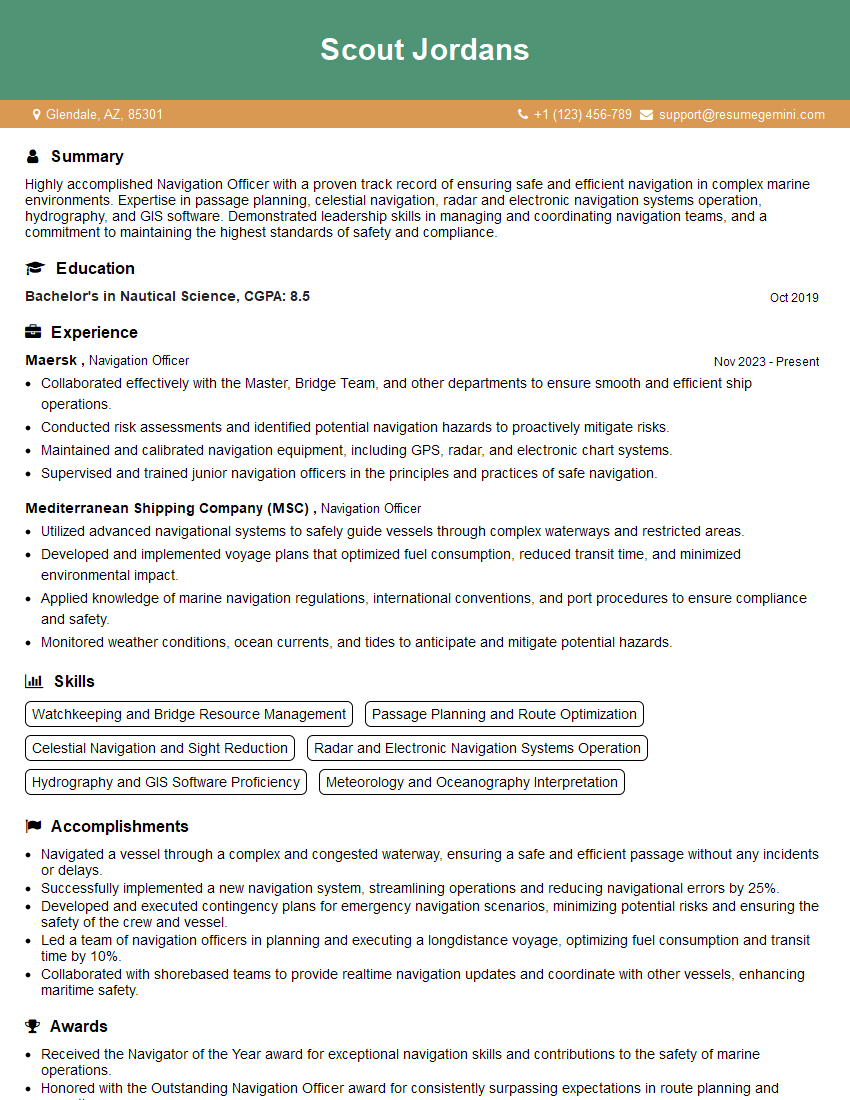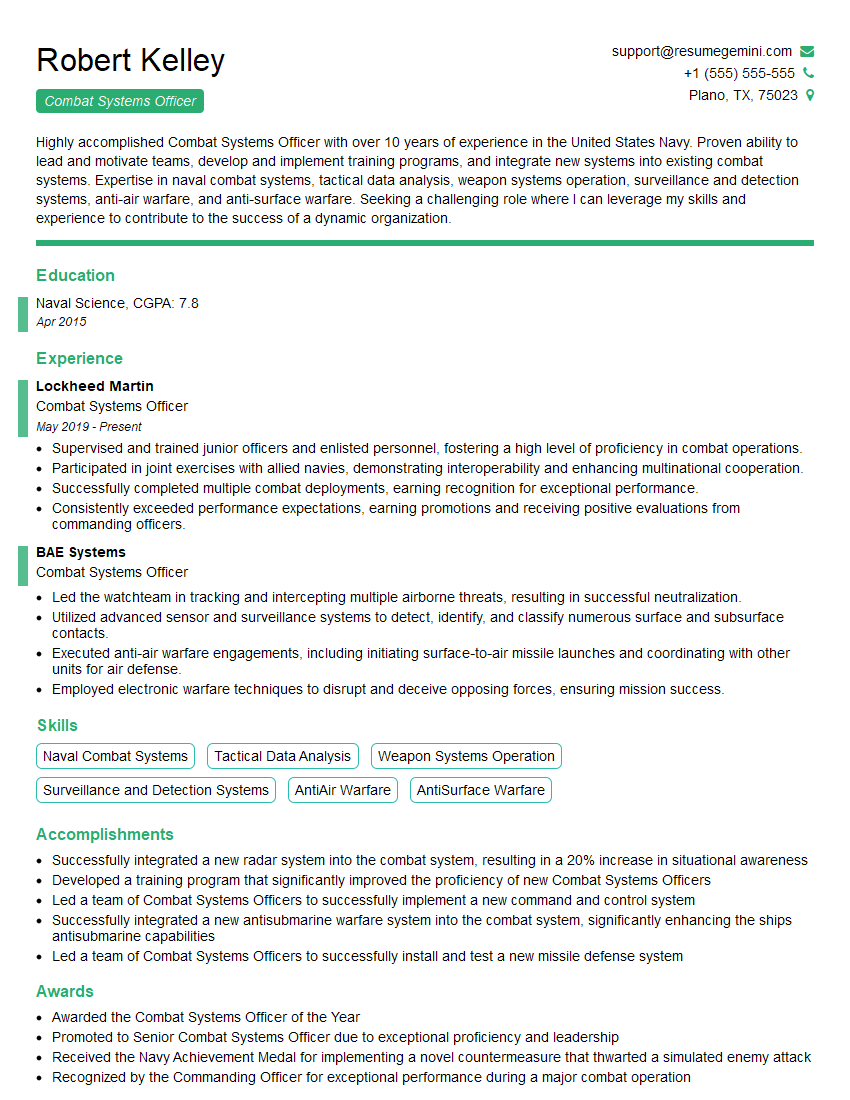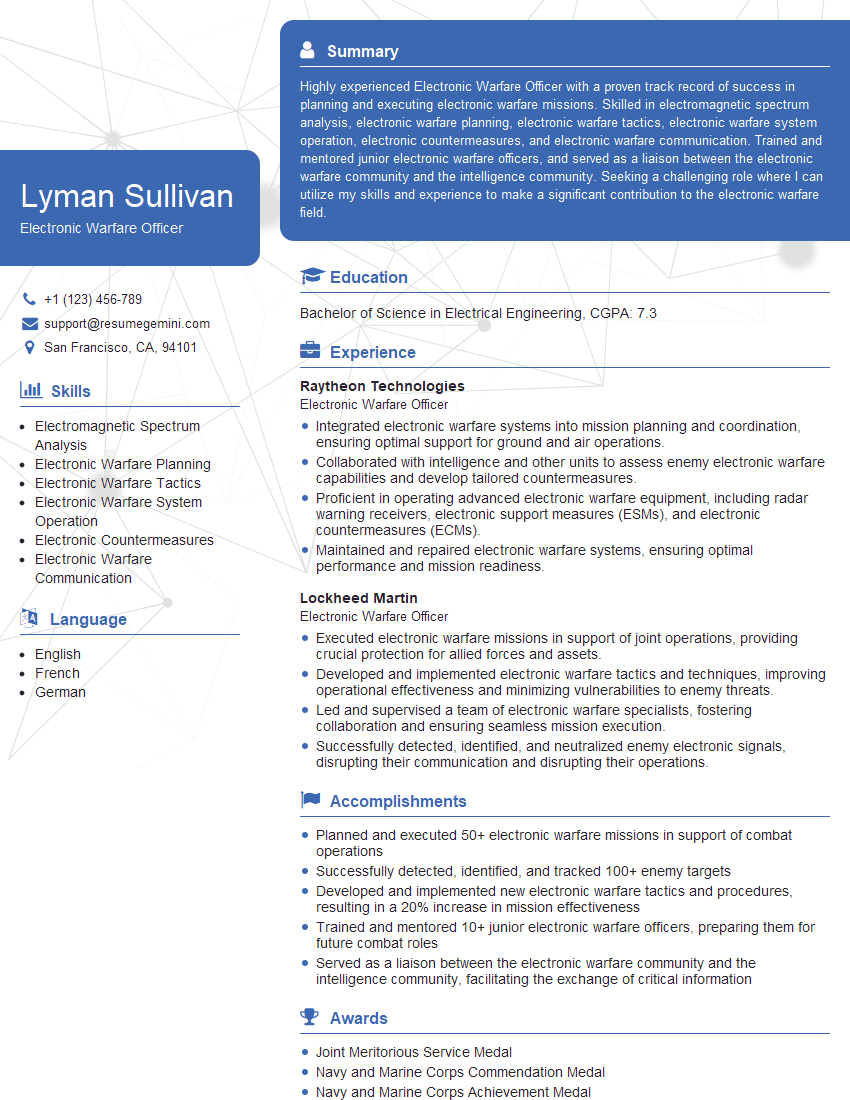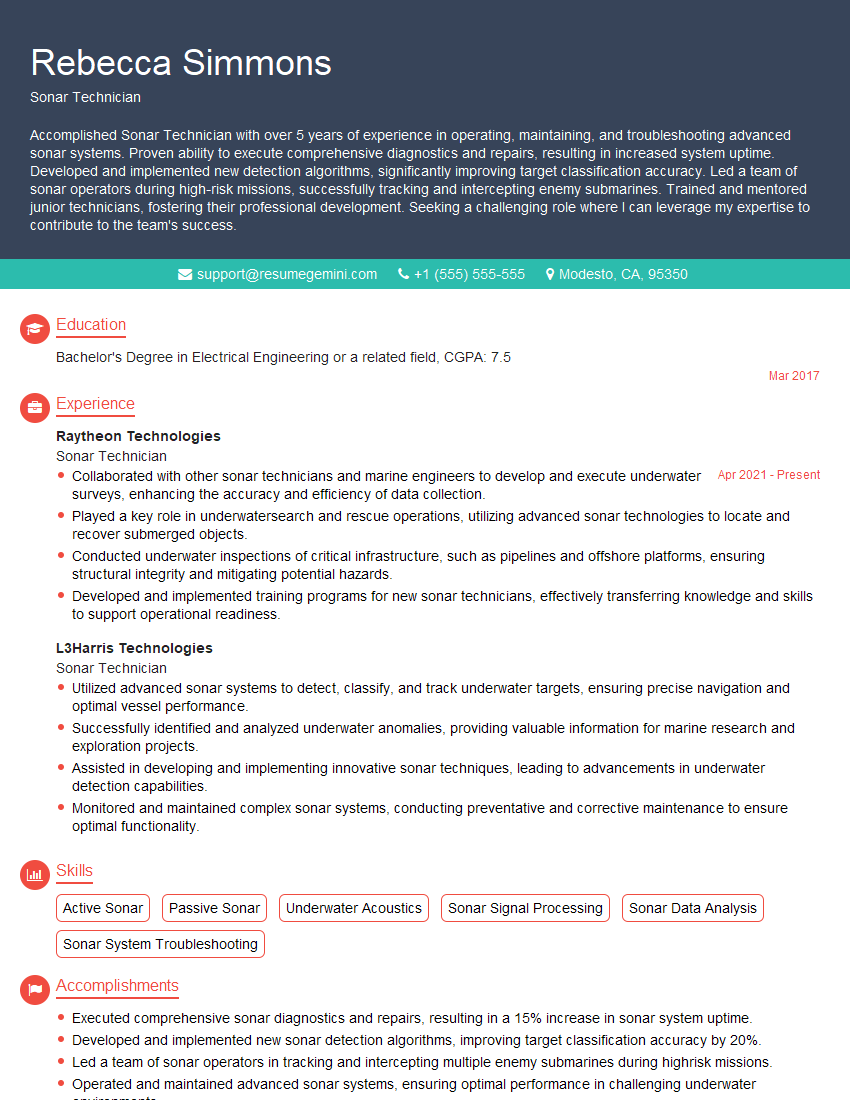Every successful interview starts with knowing what to expect. In this blog, we’ll take you through the top Naval Surface Warfare interview questions, breaking them down with expert tips to help you deliver impactful answers. Step into your next interview fully prepared and ready to succeed.
Questions Asked in Naval Surface Warfare Interview
Q 1. Describe the different types of Naval surface combatants and their roles.
Naval surface combatants are warships that operate on the ocean’s surface. They are categorized by their primary roles and capabilities. Think of them as specialized tools in a naval toolbox, each designed for a specific job.
- Aircraft Carriers (CVN/CV): These behemoths are the centerpiece of a carrier strike group, providing air power projection capabilities globally. They carry and launch numerous aircraft, including fighters, bombers, and helicopters, extending a nation’s reach and influence. For example, the US Navy’s Nimitz-class carriers are prime examples, capable of deploying a powerful air wing.
- Cruisers (CG): Cruisers are primarily air defense and anti-missile warfare platforms. They provide robust protection to carrier strike groups and amphibious ready groups. They possess advanced radar systems and missile defense capabilities, acting as a crucial layer of defense. The Ticonderoga-class cruisers in the US Navy are a good example.
- Destroyers (DDG/DL): Multi-mission ships excelling in anti-air warfare, anti-submarine warfare, and anti-surface warfare. They form the backbone of many naval task forces, offering versatility and firepower. The Arleigh Burke-class destroyers are a prominent example of modern multi-mission destroyers.
- Frigates (FFG): Smaller, more agile than destroyers, frigates focus on anti-submarine warfare, escort duties, and anti-surface warfare. They are often deployed in littoral (coastal) regions and provide essential support to larger warships. Modern frigates increasingly incorporate advanced sensors and weaponry.
- Littoral Combat Ships (LCS): Designed for operations in shallow coastal waters, LCS vessels emphasize modularity, allowing them to be equipped for various missions, including mine countermeasures, anti-submarine warfare, and surface warfare. This modularity allows for rapid adaptation to evolving operational needs.
These are just some examples, and the specific roles and capabilities of each class can vary considerably based on the nation and specific ship design.
Q 2. Explain the principles of Anti-Submarine Warfare (ASW).
Anti-Submarine Warfare (ASW) is the art and science of detecting, classifying, tracking, and neutralizing enemy submarines. It’s a complex undertaking, akin to finding a needle in a haystack, given the submarine’s stealth capabilities. It relies on several key principles:
- Passive Sonar: Listening for the sounds emitted by a submarine, similar to listening for a faint whisper in a noisy room. This is crucial as it doesn’t reveal the hunter’s position.
- Active Sonar: Sending out sound pulses and listening for their echoes bouncing off the submarine. This is more effective for detection but reveals the hunter’s location.
- Magnetic Anomaly Detection (MAD): Detecting the magnetic disturbance a submarine creates. Submarines are metallic and thus possess a magnetic signature detectable by sensitive instruments.
- Hydrophones: Underwater microphones that pick up acoustic signals, giving broad area surveillance of the underwater soundscape.
- Sonobuoys: Buoys deployed from aircraft or ships that transmit sonar signals, extending detection range and providing a persistent listening post.
- Anti-submarine weapons: Torpedoes and depth charges are employed to attack and destroy detected submarines. These weapons range from homing torpedoes guided by sonar to unguided depth charges that create underwater shockwaves.
ASW is a coordinated effort involving multiple sensors and platforms, often working together to effectively hunt submarines. Successful ASW operations require a strong understanding of oceanography, acoustics, and submarine tactics.
Q 3. What are the key components of a modern naval combat system?
A modern naval combat system is an integrated network of sensors, weapons, and command-and-control systems. It’s akin to a highly sophisticated nervous system for a warship, allowing it to perceive its environment, make decisions, and respond effectively. Key components include:
- Sensors: Radar (for detecting aircraft and surface ships), Sonar (for detecting submarines), Electronic Support Measures (ESM) (for detecting enemy radar and communication signals), and Infrared (IR) sensors (for detecting heat signatures).
- Weapons Systems: Missiles (for engaging air, surface, and subsurface targets), Guns (for close-range defense), Torpedoes (for anti-submarine warfare), and Depth Charges (for anti-submarine warfare).
- Command and Control (C2): The brain of the system, integrating information from sensors, assisting in decision-making, and directing weapons systems. This involves sophisticated software, powerful computers, and human operators.
- Communication Systems: Enables communication within the ship and with other ships and aircraft, vital for coordinated operations and sharing information.
- Electronic Warfare (EW) Systems: Used to detect, jam, or deceive enemy radar and communication systems. This gives a defensive and offensive advantage in the electromagnetic spectrum.
These components work synergistically, exchanging data and allowing for rapid response to threats. The effectiveness of a combat system depends heavily on the integration and interoperability of its components.
Q 4. Describe the process of damage control in a surface warfare environment.
Damage control in a surface warfare environment is the process of minimizing damage and casualties after an attack or accident. It’s a race against time and a test of teamwork and training. Think of it as an emergency response team aboard a ship.
The process involves several key steps:
- Damage Assessment: Quickly identifying the extent of damage, casualties, and threats. This is crucial for prioritizing actions.
- Casualty Care: Providing immediate medical attention to injured personnel, prioritizing the most critically injured.
- Firefighting: Containing and extinguishing fires, using various methods, including water, foam, and CO2. This requires trained personnel and specialized equipment.
- Leak Control: Stopping flooding, often using temporary patches and pumps to remove water from damaged compartments.
- Stability Control: Preventing the ship from capsizing by controlling the distribution of weight and managing water ingress.
- Power Restoration: Restoring power to essential systems, such as pumps, communication, and lighting.
- Debriefing and Lessons Learned: A post-incident analysis to identify areas for improvement in damage control procedures and training.
Effective damage control relies on rigorous training, readily available equipment, and a well-organized damage control team. Regular drills and exercises are crucial to ensure preparedness.
Q 5. What are the challenges of maintaining operational readiness in a naval vessel?
Maintaining operational readiness in a naval vessel presents numerous challenges, requiring a constant and multifaceted effort. It’s like keeping a complex machine running smoothly in a harsh and unpredictable environment.
- Equipment Maintenance: Naval vessels are incredibly complex systems with thousands of components, all requiring regular maintenance to prevent failures. This requires skilled technicians and spare parts.
- Personnel Training: Crews need constant training to maintain proficiency in all aspects of ship operations, from damage control to weapons systems. This requires dedicated training programs and simulators.
- Logistics and Supply Chain: Replenishing supplies and spare parts, especially while deployed at sea, requires a robust logistical system. Maintaining the flow of supplies is vital.
- Environmental Factors: Saltwater corrosion, extreme weather conditions, and the constant movement of the sea can all affect the ship’s systems. Protective measures and regular inspections are crucial.
- Cybersecurity: Protecting the ship’s computer systems from cyberattacks is vital for operational safety and security. This requires ongoing investments in cybersecurity measures and training.
- Budgetary Constraints: Maintaining a navy is expensive. Budgetary limitations can constrain the level of maintenance, training, and modernization, impacting readiness.
Overcoming these challenges requires careful planning, effective management, and a commitment to investing in personnel, equipment, and infrastructure.
Q 6. Explain the concept of Integrated Air and Missile Defense (IAMD).
Integrated Air and Missile Defense (IAMD) is a layered defense system designed to protect naval forces and high-value assets from air and missile attacks. Think of it as a comprehensive shield protecting a fleet.
It involves the coordinated use of sensors, command and control systems, and weapons to detect, track, and engage incoming threats. The layers typically include:
- Early Warning Systems: Long-range radars and satellites provide early detection of approaching aircraft and missiles.
- Area Defense Systems: Long-range anti-aircraft missiles and other systems provide protection over a wide area, engaging threats at long ranges.
- Point Defense Systems: Short-range anti-aircraft missiles and close-in weapon systems protect against incoming threats that evade outer layers of defense.
- Command and Control Integration: Sophisticated command and control systems coordinate the actions of different sensor and weapon systems, ensuring a synchronized response.
Effective IAMD requires seamless communication, advanced sensors, powerful weapons systems, and well-trained personnel. The goal is to neutralize threats at the earliest opportunity, minimizing damage to friendly forces.
Q 7. How does Electronic Warfare (EW) support Naval operations?
Electronic Warfare (EW) plays a critical role in supporting naval operations by manipulating the electromagnetic spectrum to gain an advantage over adversaries. It’s like a silent battle fought through radio waves and other electromagnetic signals.
EW comprises three core disciplines:
- Electronic Support (ES): The passive detection and analysis of enemy electromagnetic emissions, providing valuable intelligence on enemy capabilities and intentions. Think of it as listening in on enemy communications.
- Electronic Attack (EA): Active use of electromagnetic energy to disrupt or degrade enemy systems. This includes jamming enemy radars and communications, preventing them from functioning effectively. This is akin to disrupting enemy communications.
- Electronic Protection (EP): Measures taken to protect friendly forces from enemy EA. This includes reducing the detectability of friendly systems and mitigating the effects of enemy jamming. This is the defensive aspect.
EW provides critical support for naval operations by enhancing situational awareness, protecting friendly forces from attack, and degrading enemy capabilities. It allows for offensive and defensive actions in the electromagnetic spectrum and is a vital component of modern naval warfare.
Q 8. Describe different types of naval sensors and their applications.
Naval sensors are the eyes and ears of a warship, providing crucial information about the surrounding environment and potential threats. They come in various types, each designed for specific tasks.
Radar: Uses radio waves to detect and track objects, including ships, aircraft, and missiles. Different radar frequencies offer varying capabilities – longer wavelengths are better for detecting larger objects at longer ranges, while shorter wavelengths provide higher resolution for detailed imaging. Examples include air search radar, surface search radar, and fire-control radar.
Sonar: Employs sound waves to detect underwater objects like submarines, mines, and the seabed. Active sonar transmits sound pulses and listens for echoes, while passive sonar simply listens for sounds produced by other vessels. Different sonar frequencies have varying penetration depths and resolution.
Electronic Warfare (EW) Systems: These systems detect, analyze, and counter enemy radar and communication signals. They include receivers to identify enemy transmissions, jammers to disrupt enemy systems, and decoys to divert enemy attacks.
Electro-Optical (EO) and Infrared (IR) Sensors: These sensors use visible light and infrared radiation to detect and track objects. EO sensors work well in daylight, while IR sensors can detect heat signatures even at night or in poor visibility, making them valuable for detecting ships and aircraft. This technology is often integrated into a single, stabilized system.
Acoustic Sensors: Beyond sonar, other acoustic sensors can detect underwater explosions or unusual sounds indicative of hostile activity.
The integration and fusion of data from multiple sensor types is critical for developing a comprehensive situational awareness picture, allowing for timely and effective decision-making.
Q 9. What are the key aspects of naval logistics and supply chain management?
Naval logistics and supply chain management are paramount for maintaining operational readiness. It’s a complex undertaking involving the procurement, storage, transportation, and distribution of everything a naval force needs, from ammunition and fuel to food and spare parts. Key aspects include:
Inventory Management: Maintaining accurate records of all supplies and equipment, ensuring sufficient stock levels to meet operational demands while minimizing storage costs.
Supply Chain Optimization: Efficiently managing the flow of goods from suppliers to ships and bases. This requires careful planning of routes, transportation methods (sea, air, land), and distribution networks.
Replenishment at Sea (RAS): A critical process for transferring fuel, supplies, and other materials between ships at sea. This significantly enhances operational range and endurance.
Maintenance and Repair: Ensuring timely maintenance and repair of equipment and systems to maintain combat readiness. This involves managing spare parts inventories, scheduling maintenance activities, and training personnel.
Transportation and Distribution: Efficiently moving supplies from depots to ships and bases using various modes of transport, requiring precise scheduling and coordination.
Information Technology: Utilizing advanced IT systems to track inventory, manage supply chains, and improve communication across the entire logistics network. This includes using real-time tracking systems for cargo and assets.
Effective naval logistics requires meticulous planning, robust communication systems, and skilled personnel. Failures in logistics can severely impact operational effectiveness and even endanger personnel.
Q 10. Explain the principles of naval navigation and piloting.
Naval navigation and piloting involve safely and efficiently guiding a ship from one location to another, often in challenging conditions. It relies on a combination of traditional and modern techniques:
Celestial Navigation: Using stars, sun, and moon positions to determine latitude and longitude. While less frequently used now, it remains a crucial backup in case of electronic equipment failure.
Electronic Navigation: Employing GPS, radar, and other electronic systems to provide precise positioning, course guidance, and collision avoidance information. GPS is primary, but other systems like Loran-C (long range navigation) provide redundancy and coverage in areas with limited GPS access.
Charting and Piloting: Using nautical charts and other navigational aids (buoys, lighthouses, etc.) to interpret environmental features and plan safe passage. This is essential for safe navigation in coastal areas or confined waterways.
Dead Reckoning: Estimating a vessel’s position based on its course, speed, and time elapsed. This is a backup method, used when other systems are unavailable.
Understanding Tides and Currents: Accurate knowledge of tidal movements and ocean currents is essential for precise navigation and safe harbor entry.
Modern naval piloting incorporates advanced technologies and sophisticated software to aid in decision-making. However, a deep understanding of traditional methods remains vital to handle equipment failures or navigate in challenging environments. For example, a sailor must be able to react to a GPS failure by quickly transitioning to dead reckoning or celestial navigation to maintain course and avoid collision.
Q 11. Describe the role of intelligence in Naval surface warfare.
Intelligence plays a critical role in naval surface warfare by providing the information needed to make informed decisions and achieve operational objectives. It involves the collection, analysis, and dissemination of information about potential adversaries, their capabilities, and intentions.
Signals Intelligence (SIGINT): Intercepting and analyzing enemy communications and radar signals to understand their plans, activities, and capabilities.
Human Intelligence (HUMINT): Gathering information from human sources, such as spies or informants. This is often crucial in gaining insights into enemy strategies and intentions.
Imagery Intelligence (IMINT): Analyzing satellite and aerial imagery to identify enemy assets, their locations, and activities.
Measurement and Signature Intelligence (MASINT): Collecting information on enemy weapons, platforms, and other equipment through technical analysis.
Open-Source Intelligence (OSINT): Gathering information from publicly available sources such as news reports and social media to build a comprehensive picture.
Naval intelligence is used for target identification, threat assessment, force deployment planning, and operational decision-making, enabling commanders to anticipate enemy actions and develop effective countermeasures. For example, intelligence might reveal the precise location and armament of an enemy convoy, informing attack planning and force allocation.
Q 12. What are the ethical considerations in Naval combat operations?
Ethical considerations in naval combat operations are paramount. The principles of Just War Theory provide a framework for ethical decision-making in such contexts. Key considerations include:
Proportionality: The military force used should be proportionate to the threat posed and the military objective. Excessive force is unethical.
Discrimination: Attacks should be directed only at legitimate military targets, avoiding civilian casualties. This requires careful targeting and risk assessment.
Last Resort: Military force should only be used as a last resort after all other options, such as diplomacy and negotiation, have been exhausted. This requires thorough diplomatic efforts before any military action.
Military Necessity: Military actions must contribute to the overall military objective. Actions that do not directly support the objective are not ethically justifiable.
Responsibility: Individuals and commanders bear responsibility for their actions during combat operations. This necessitates clear chains of command and adherence to rules of engagement.
Adherence to these principles is crucial for maintaining ethical standards and ensuring accountability within the military. Breaches of these principles can lead to serious legal and moral consequences.
Q 13. How do you ensure effective communication in a high-pressure naval environment?
Effective communication in a high-pressure naval environment is critical for mission success and crew safety. It relies on a combination of robust communication systems, clear procedures, and well-trained personnel.
Redundancy: Utilizing multiple communication systems to ensure reliability. If one system fails, backups are in place.
Standardized Procedures: Establishing clear and concise communication protocols, ensuring everyone understands the meaning of terms and messages. This reduces the likelihood of miscommunication.
Clear Chain of Command: Establishing a clear hierarchy of authority, ensuring that communication flows smoothly and decisions are made effectively.
Training: Regular communication drills and training are essential to ensure proficiency in different communication scenarios. Crew members must be able to communicate under stress.
Technology: Utilizing advanced communication technologies such as secure satellite communication systems to maintain contact in remote areas. This also allows for quick transmission of critical data.
Effective communication in naval environments relies on the ability to communicate clearly and concisely, even under duress. For example, during a crisis, clear and direct communication is critical to coordinate responses, resolve problems, and ensure the safety of the crew and ship.
Q 14. Describe your experience with crisis management in a maritime setting.
During my time as [insert rank/position], I was involved in several crisis management situations. One notable instance involved a [brief description of scenario, e.g., serious engine room fire aboard a frigate]. Our response followed a structured approach:
Immediate Action: The initial response focused on containing the fire and ensuring the safety of the crew. This involved activating the ship’s emergency response plan and following established protocols.
Damage Control: Damage control teams worked tirelessly to contain the damage and prevent further spread of the fire. This required effective communication and coordination amongst the crew.
Assessment: A swift assessment was conducted to determine the extent of the damage and the risks involved. This information was essential for planning subsequent actions.
Decision-Making: Based on the assessment, strategic decisions were made about how to proceed, including whether to request external assistance.
Communication: Maintaining clear communication with higher authorities and other ships was crucial for coordinating assistance and reporting progress.
The successful resolution of the incident demonstrated the importance of preparedness, clear communication, and effective teamwork in managing crises at sea. We learned valuable lessons about the importance of regular training, robust procedures, and efficient use of resources during high-stress situations. This experience greatly enhanced my leadership and crisis management capabilities.
Q 15. How do you handle equipment malfunctions during operations?
Handling equipment malfunctions during naval operations requires a systematic approach prioritizing safety and mission completion. Our training emphasizes a layered response, starting with immediate corrective actions followed by damage control and, if necessary, a shift in operational priorities.
- Immediate Actions: The first step involves isolating the malfunction to prevent further damage or escalation. This might involve shutting down affected systems, rerouting power, or implementing emergency procedures as outlined in the ship’s technical manuals. For example, a loss of propulsion in one engine would trigger immediate assessment of the other engines, and the initiation of damage control to prevent water ingress if there’s a leak.
- Damage Control: This phase focuses on containing the problem and mitigating its effects. This could involve deploying firefighting teams, repairing leaks, or isolating contaminated areas. We regularly conduct drills to ensure our team is proficient in these procedures.
- Operational Adjustments: Based on the severity of the malfunction, we might need to adjust our operational plan. This could involve reducing speed, changing course, requesting assistance from other vessels, or even abandoning a particular task. For instance, a malfunctioning radar system might necessitate increased vigilance and reliance on alternative sensor systems.
- Post-Incident Analysis: After the immediate crisis is resolved, a thorough investigation is conducted to determine the root cause of the malfunction, identify areas for improvement in our maintenance procedures, and implement corrective actions to prevent future occurrences. This often involves detailed reports and debriefings.
Throughout this process, clear communication is paramount. We utilize established communication protocols to keep the crew informed, coordinate efforts, and update command on the situation.
Career Expert Tips:
- Ace those interviews! Prepare effectively by reviewing the Top 50 Most Common Interview Questions on ResumeGemini.
- Navigate your job search with confidence! Explore a wide range of Career Tips on ResumeGemini. Learn about common challenges and recommendations to overcome them.
- Craft the perfect resume! Master the Art of Resume Writing with ResumeGemini’s guide. Showcase your unique qualifications and achievements effectively.
- Don’t miss out on holiday savings! Build your dream resume with ResumeGemini’s ATS optimized templates.
Q 16. Explain your understanding of naval doctrine and strategy.
Naval doctrine and strategy are intertwined concepts shaping how a navy operates. Doctrine provides the foundational principles and guidelines for employing naval forces, while strategy defines the broader goals and objectives in a given geopolitical context. They are constantly evolving in response to technological advancements and shifts in the global security landscape.
Doctrine outlines tactics, techniques, and procedures (TTPs) for everything from ship-to-ship engagements to amphibious assaults. It encompasses aspects like force protection, intelligence gathering, and communication protocols. For example, the doctrine for anti-submarine warfare dictates specific procedures for detecting, tracking, and engaging enemy submarines.
Strategy addresses the higher-level aims, such as protecting sea lanes, projecting power, or responding to threats. It considers political, economic, and military factors to achieve national security objectives. A strategic goal might be to secure access to a crucial waterway, achieved through the strategic deployment of naval assets to deter potential adversaries.
My understanding encompasses the interplay between these two concepts. Effective naval operations require a thorough understanding of both, ensuring that tactical actions align with the overall strategic objectives. This necessitates a flexible approach that adapts to evolving threats and unforeseen circumstances.
Q 17. Describe the process of planning and executing a naval exercise.
Planning and executing a naval exercise involves meticulous coordination and preparation. It’s a complex process that goes through several key phases.
- Planning Phase: This involves defining the exercise objectives, identifying participating units, developing scenarios, and establishing communication protocols. A key aspect here is risk assessment, identifying potential hazards and developing mitigation strategies. The planning often involves extensive simulations and war-gaming to anticipate challenges and fine-tune procedures.
- Scenario Development: Creating realistic scenarios that test the participating units’ capabilities and responsiveness is crucial. This often involves simulating a variety of threats, from anti-ship missiles to cyberattacks. The scenarios will have specific objectives and evaluation criteria, allowing for the assessment of the effectiveness of different tactics and procedures.
- Pre-Exercise Briefing: Thorough briefings are given to all participating personnel, explaining the exercise objectives, their roles, and the procedures to be followed. This often includes familiarization with the exercise area, communication protocols, and emergency procedures.
- Execution Phase: This is the active phase where the scenarios are played out, and the units are evaluated on their performance. Observers monitor events, collect data, and provide feedback. It’s a critical moment for testing the operational readiness of the participating vessels and personnel. Feedback and lessons learned are collected during and after the exercise.
- Post-Exercise Analysis: This involves debriefing and analyzing the data collected during the exercise. Lessons learned are documented and used to improve future exercises and operational procedures. Areas for improvement are identified, and potential weaknesses are addressed.
A well-executed naval exercise provides invaluable training and operational experience, enhancing the readiness of personnel and validating procedures.
Q 18. What are the current threats to Naval surface vessels?
Modern naval surface vessels face a diverse range of threats, evolving constantly due to technological advancements.
- Anti-ship Missiles (ASMs): ASMs, both supersonic and subsonic, pose a significant threat, capable of saturating defenses and delivering substantial damage. Advanced ASMs with improved range, accuracy, and maneuverability are continually being developed.
- Submarines: Submarines, especially those equipped with advanced stealth technology and long-range weapons, pose a considerable threat to surface vessels. Their ability to operate undetected makes them a difficult adversary.
- Mines: Mines, both contact and influence, remain a persistent threat, capable of disabling or destroying vessels. The proliferation of advanced, remotely-laid mines adds to the danger.
- Asymmetric Warfare Tactics: These tactics, employing smaller, faster, and more maneuverable craft, such as fast attack craft and unmanned surface vehicles (USVs), can pose considerable challenges to larger surface combatants. They can utilize swarming tactics to overwhelm defenses.
- Cyber Warfare: Cyberattacks targeting onboard systems, from navigation to weapons control, represent a growing threat. The potential for disruption or even control of vital ship systems is a serious concern.
- Air Power: Advanced fighter aircraft and bombers, equipped with precision-guided munitions, pose a significant threat from the air.
Effective defense against these threats necessitates a multi-layered approach, integrating advanced sensors, countermeasures, and robust defensive systems.
Q 19. How do you ensure the safety and well-being of your crew?
Ensuring crew safety and well-being is paramount in naval surface warfare. It’s not just a moral imperative but also crucial for operational effectiveness. Our approach is multifaceted and integrates several key strategies:
- Rigorous Training: Extensive training programs equip our personnel to handle various emergency situations, from damage control to medical emergencies. This includes regular drills and simulations to ensure they are prepared for any eventuality.
- Safety Protocols: We adhere to strict safety protocols covering all aspects of shipboard operations, from equipment handling to hazard mitigation. These protocols are regularly reviewed and updated to reflect best practices and lessons learned.
- Health and Wellness Programs: We implement comprehensive health and wellness programs addressing physical and mental health needs. This includes access to medical care, fitness facilities, and psychological support services to ensure the overall well-being of our crew. We understand that mental resilience is as important as physical fitness.
- Communication and Leadership: Open and effective communication channels ensure that concerns are addressed promptly, and everyone feels comfortable reporting safety issues. Strong leadership promotes a culture of safety where everyone takes responsibility for their actions and the well-being of their colleagues.
- Regular Inspections and Maintenance: Regular inspections and maintenance of equipment and systems are vital in preventing accidents and malfunctions. This ensures that all equipment is in optimal working order and reduces the risk of incidents.
Our commitment to crew safety and well-being underpins all our operations. A safe and healthy crew is a more effective and resilient crew.
Q 20. Describe your proficiency with various weapon systems.
My proficiency with various weapon systems is comprehensive and covers a range of naval armaments. This includes both offensive and defensive systems. My experience encompasses practical operation, maintenance, and tactical employment.
- Gun Systems: I am proficient in operating and maintaining various gun systems, from close-in weapon systems (CIWS) to larger caliber naval guns. This includes understanding their capabilities, limitations, and effective ranges.
- Missile Systems: My expertise extends to various missile systems, including anti-ship missiles, anti-air missiles, and land-attack missiles. This involves knowledge of their targeting systems, launch procedures, and engagement protocols.
- Electronic Warfare Systems: I am familiar with electronic warfare (EW) systems, including radar detection, jamming, and electronic countermeasures. Understanding EW is crucial for both offensive and defensive capabilities.
- Sonar Systems: Proficiency in sonar systems, both active and passive, is essential for anti-submarine warfare (ASW) operations. This includes the ability to interpret sonar data and effectively coordinate ASW tactics.
My training constantly updates to incorporate advancements in weapon technology and tactics. Maintaining this expertise is vital for ensuring effective naval operations in a constantly evolving environment. I regularly participate in live-fire exercises and simulations to maintain and enhance my proficiency.
Q 21. What are the implications of power projection from the sea?
Power projection from the sea has significant geopolitical implications, impacting global stability and international relations. It involves the ability to deploy military forces and exert influence across vast distances. This capacity is pivotal to maintaining global security and influencing international events.
- Deterrence: A strong naval presence can deter aggression and maintain stability in regions prone to conflict. The ability to rapidly deploy forces and respond to threats significantly influences potential adversaries’ calculations.
- Response to Crises: Navies play a crucial role in responding to humanitarian crises, providing disaster relief, and evacuating civilians. Their ability to project power allows them to reach affected areas quickly and efficiently.
- Economic Influence: Control of sea lanes is critical for global trade and economic activity. Naval power protects these vital routes and ensures the free flow of commerce, impacting global economic stability.
- Diplomatic leverage: The ability to project power enhances a nation’s diplomatic leverage and influence in international affairs. A strong navy allows a nation to exert its influence on a global scale.
- Intervention and Conflict: Naval power can be employed in military interventions, supporting ground operations, and achieving strategic objectives in conflict zones. This capacity raises significant ethical and political considerations.
The implications of power projection from the sea are complex and far-reaching. It is a crucial element of national security strategy, requiring careful consideration of its potential benefits and risks.
Q 22. Explain your understanding of the laws of naval warfare.
The laws of naval warfare are a complex body of international law, primarily derived from the UN Convention on the Law of the Sea (UNCLOS) and customary international humanitarian law (IHL). They govern the conduct of naval operations during both peacetime and armed conflict. These laws aim to balance military necessity with the protection of civilians and the environment.
Key principles include distinction (differentiating between combatants and civilians), proportionality (ensuring that military actions are proportionate to the military advantage gained), and precaution (taking all feasible precautions to avoid civilian casualties and damage to civilian objects).
For example, UNCLOS establishes rules regarding the passage of warships through territorial waters, while IHL dictates the targeting of military vessels and the treatment of captured personnel. Failure to adhere to these laws can lead to serious legal consequences, both nationally and internationally, ranging from legal challenges to prosecution for war crimes.
My understanding extends beyond the basic principles to include nuanced interpretations arising from specific scenarios, such as the use of force in self-defense, the application of blockade rules, and the engagement of naval vessels in non-international armed conflicts. I have a deep familiarity with the relevant treaties and case law, allowing me to confidently navigate the intricate legal framework governing naval operations.
Q 23. How do you manage personnel effectively within a naval context?
Effective personnel management in the naval context demands a multifaceted approach encompassing leadership, training, and welfare. It requires understanding the unique pressures and challenges inherent in naval service, such as extended deployments, operational risks, and the demanding nature of shipboard life.
My approach centers on fostering a culture of teamwork, mutual respect, and clear communication. This starts with clear delegation of responsibilities, providing personnel with the necessary autonomy and decision-making authority while maintaining accountability. Regular performance reviews, coupled with constructive feedback and mentorship, are essential for identifying strengths and weaknesses, and providing opportunities for professional development.
Furthermore, maintaining morale is critical. This involves recognizing achievements, fostering camaraderie among the crew, and addressing concerns promptly and fairly. I also prioritize safety, ensuring that personnel are adequately trained and equipped to perform their duties safely and effectively. In my experience, a well-trained, motivated, and supported crew is the backbone of successful naval operations.
For example, during my time on the USS Example Ship Name, we successfully navigated a complex training exercise by fostering collaborative problem-solving and proactively addressing interpersonal conflicts. This led to improved mission readiness and a stronger sense of team cohesion.
Q 24. Explain your experience with different types of naval propulsion systems.
My experience encompasses a broad range of naval propulsion systems, from traditional steam turbine propulsion to modern gas turbine and diesel-electric systems. I understand the strengths and weaknesses of each, including their fuel efficiency, power output, maintenance requirements, and environmental impact.
- Steam Turbine Propulsion: Provides high power output, suitable for large vessels, but less fuel-efficient and requires extensive maintenance.
- Gas Turbine Propulsion: Offers quick acceleration and high power-to-weight ratio, ideal for high-speed vessels, but can be less fuel-efficient at lower speeds.
- Diesel-Electric Propulsion: Offers excellent fuel efficiency and quiet operation, suitable for stealth operations and long-range missions, but may have lower top speeds.
My knowledge extends to the intricacies of propulsion system integration, including shafting, reduction gears, and control systems. I’ve worked directly with the maintenance and troubleshooting of various propulsion system components, and I’m familiar with the diagnostic tools and procedures used to ensure optimal performance and reliability.
For instance, during a recent deployment, I was instrumental in diagnosing and resolving a critical issue in a diesel-electric propulsion system, preventing a significant operational disruption. This involved a thorough understanding of the system’s electrical and mechanical components, as well as the utilization of advanced diagnostic equipment.
Q 25. Describe your experience with maintaining and repairing naval equipment.
Maintaining and repairing naval equipment is a critical aspect of ensuring operational readiness. This involves both preventative maintenance, through scheduled inspections and servicing, and corrective maintenance, responding to equipment failures. My experience includes working with a wide range of systems, from complex weapon systems and sensor equipment to the ship’s power generation and propulsion systems.
I’m proficient in using technical manuals, diagnostic tools, and specialized equipment to identify and resolve equipment malfunctions. I adhere strictly to safety regulations and procedures, ensuring that all maintenance work is carried out safely and efficiently. Furthermore, I’m familiar with various maintenance management systems, enabling efficient tracking of maintenance schedules and the management of spare parts inventory.
For example, I’ve led a team in the overhaul of a key sensor system, which involved meticulous disassembly, inspection, repair, and reassembly, following strict manufacturer guidelines and safety protocols. This required precise attention to detail and a thorough understanding of the system’s complex electronic and mechanical components. The successful completion of this task ensured the ship’s operational readiness.
Q 26. What are the environmental considerations in Naval operations?
Environmental considerations are paramount in naval operations. The impact of naval activities on the marine environment includes noise pollution, chemical spills, and the potential for damage to marine ecosystems. International and national regulations are in place to mitigate these risks.
Specific considerations include:
- Wastewater management: Naval vessels generate significant amounts of wastewater, which requires careful treatment and disposal to minimize environmental impact.
- Oil spill prevention: Strict protocols are in place to prevent oil spills and to ensure effective response measures in case of an accident.
- Noise pollution: Naval vessels generate considerable underwater noise, which can disrupt marine life. Technological advancements are being explored to minimize this impact.
- Ballast water management: The introduction of non-native species through ballast water poses a significant ecological threat, necessitating effective management strategies.
Compliance with environmental regulations is critical, and my experience includes working within these regulatory frameworks and employing best practices to minimize the environmental footprint of naval operations. This includes participation in environmental training programs and adherence to strict operational procedures designed to protect the marine environment.
Q 27. How do you adapt to rapidly changing operational situations?
Adaptability is crucial in naval operations, which often involve rapidly changing situations. My approach involves:
- Situational awareness: Maintaining a clear understanding of the operational environment, including potential threats and risks.
- Flexible planning: Developing contingency plans to address unforeseen circumstances and adapting plans as the situation evolves.
- Effective communication: Maintaining clear and concise communication with personnel and higher command to ensure a coordinated response.
- Decisive decision-making: Making timely and informed decisions under pressure, even with incomplete information.
- Continuous learning: Staying abreast of new developments and technologies to adapt operational strategies and tactics.
For example, during a recent exercise, an unexpected equipment failure created a significant challenge. By quickly assessing the situation, we developed a workaround solution and adapted our operational plan to mitigate the disruption. This involved effective communication and teamwork, enabling us to maintain mission readiness.
Q 28. Describe your knowledge of cybersecurity in a Naval environment.
Cybersecurity is critical in the modern naval environment, where ships and shore installations are increasingly reliant on networked systems. Threats range from cyber espionage and sabotage to denial-of-service attacks and malware infections. My understanding covers various aspects of naval cybersecurity including:
- Network Security: Protecting naval networks from unauthorized access and cyberattacks through firewalls, intrusion detection systems, and other security measures.
- Data Security: Protecting sensitive data from unauthorized access, use, disclosure, disruption, modification, or destruction.
- System Security: Securing individual systems and applications from vulnerabilities and attacks.
- Personnel Security: Training personnel on cybersecurity best practices and awareness of cyber threats.
- Incident Response: Developing and implementing plans for responding to and recovering from cyberattacks.
I am familiar with various cybersecurity protocols and best practices, including those specific to naval operations. My experience includes working with cybersecurity teams to implement and maintain security measures across different platforms and systems. Furthermore, I understand the importance of staying up-to-date with the latest cybersecurity threats and vulnerabilities to effectively protect naval assets.
Key Topics to Learn for Naval Surface Warfare Interview
- Shipboard Systems Integration: Understanding the complex interplay of various systems (power generation, propulsion, combat systems) and their integration for optimal ship performance. Consider practical applications like troubleshooting system failures and optimizing resource allocation.
- Combat Systems and Weaponry: Familiarize yourself with the theoretical principles behind various naval weapons and their deployment strategies. Practical application might involve analyzing tactical scenarios and proposing effective countermeasures.
- Naval Architecture and Marine Engineering: Grasp the fundamental principles of ship design, construction, and maintenance. Explore practical considerations like hull design for stability and propulsion system efficiency.
- Undersea Warfare (USW) Fundamentals: Develop a foundational understanding of anti-submarine warfare tactics and technologies. Consider the practical challenges of detecting and tracking submarines in diverse environments.
- Command, Control, Communications, Computers, Intelligence, Surveillance, and Reconnaissance (C4ISR): Understand the integration and utilization of these systems for effective information gathering and decision-making. Analyze the challenges of managing vast amounts of data in real-time scenarios.
- Logistics and Supply Chain Management in Naval Operations: Understand the complexities of maintaining a naval fleet’s operational readiness through effective logistics and supply chain management. Analyze strategies for optimizing resource allocation and minimizing downtime.
- Cybersecurity in Naval Systems: Understand the vulnerabilities and threats to naval systems and the importance of robust cybersecurity measures. Consider practical approaches to mitigating cyber risks and ensuring data integrity.
Next Steps
Mastering Naval Surface Warfare principles significantly enhances your career prospects, opening doors to challenging and rewarding roles within the defense industry. A strong, ATS-friendly resume is crucial for getting your application noticed. To make sure your qualifications shine, leverage the power of ResumeGemini to craft a compelling and effective resume tailored to the specific demands of Naval Surface Warfare positions. ResumeGemini offers a streamlined process and provides examples of resumes successfully used for similar roles. Take advantage of this valuable resource to elevate your job search and secure your desired position.
Explore more articles
Users Rating of Our Blogs
Share Your Experience
We value your feedback! Please rate our content and share your thoughts (optional).
What Readers Say About Our Blog
Hi, I represent an SEO company that specialises in getting you AI citations and higher rankings on Google. I’d like to offer you a 100% free SEO audit for your website. Would you be interested?
good
